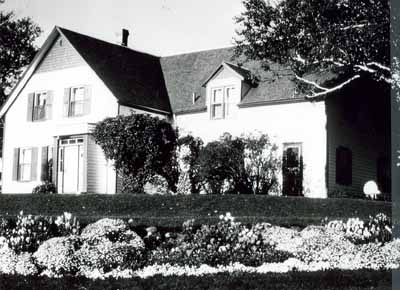Green Gables House
Recognized Federal Heritage Building
Cavendish, Prince Edward Island

Corner view
© Parks Canada | Parcs Canada, J. Sylvester, 2000.
Address :
8619 Cavendish Road, Cavendish, Prince Edward Island
Recognition Statute:
Treasury Board Policy on Management of Real Property
Designation Date:
1985-07-24
Dates:
-
1831 to 1870
(Construction)
Event, Person, Organization:
Custodian:
Parks Canada
FHBRO Report Reference:
84-50
DFRP Number:
02087 01
Description of Historic Place
Green Gables House sits in the midst of Prince Edward Island National Park of Canada. A warm and welcoming residence, the one-and-a-half storey house is painted white and topped by the famous green-gable roof. Its front façade is highlighted by a dormer window, a small vestibule entrance, and green shutters that flank the double pane, wood, sash windows. The designation is confined to the footprint of the building.
Heritage Value
Green Gables House is a Recognized Federal Heritage Building because of its historical associations, and its architectural and environmental value.
Historical Value
Green Gables House is internationally famous as one of Canada’s most celebrated fictional houses. It is one of the best examples of a building associated with the Canadian author, Lucy Maud Montgomery, who used the farmhouse as both the inspiration and the setting for her famous novel, “Anne of Green Gables.” The story was an instant success in 1908 and has since been translated into 17 languages. Green Gables House has been of interest to tourists since the publication of the novel, and has played an important role in the interpretive programs of Prince Edward Island National Park of Canada.
Architectural Value
Green Gables House is valued for its good aesthetic and functional design. Its farmhouse design, built in successive stages, places it firmly in Canadian vernacular building traditions of the 19th century. It is of a type very common in Prince Edward Island and most of eastern Canada. The interior of the house has since been reconstructed to appear as it did in the novels.
Environmental Value
Green Gables House reinforces the picturesque character of its recreational setting at Prince Edward Island National Park of Canada and has become a symbol of the region.
Sources: Sally Coutts, Green Gables, Prince Edward Island National Park, Cavendish, Prince Edward Island, Federal Heritage Buildings Review Office, Building Report, 84-050; Green Gables House, Prince Edward Island National Park, Cavendish, Prince Edward Island, Heritage Character Statement, 84-050.
Character-Defining Elements
The following character-defining elements of Green Gables House should be respected.
Its good aesthetic and functional design and good craftsmanship and materials, for example: the one-and-a-half storey, L-shaped massing topped by a gable roof with a dormer window on the front façade; the small vestibule entrance; the wood frame construction clad in white painted shingles; the window arrangement and the green shutters as well as the gable ends which have traditionally been green; the interior plan, finishes and details.
The manner in which Green Gables House reinforces the picturesque character of its recreational park setting and is a symbolic landmark in the region, as evidenced by: its overall scale, design and materials, which contribute to its park surroundings; its role as a symbolic landmark, due to its literary associations; its role as part of the Prince Edward Island National Park of Canada interpretive program, which makes it familiar to international tourists and visitors of the park.
Heritage Character Statement
Disclaimer -
The heritage character statement was developed by FHBRO to explain the reasons for the designation of a federal heritage building and what it is about the building that makes it significant (the heritage character). It is a key reference document for anyone involved in planning interventions to federal heritage buildings and is used by FHBRO in their review of interventions.
SUMMARY
Built in stages between 1831 and 1870's, and located in the midst of Prince Edward Island National Park, the Green Gables House was the inspiration for the home of the fictional character Anne Shirley, heroine of L.M. Montgomery's famous novel Anne of Green Gables. This literary association as well as landmark convey a significant heritage value to the house, which holds and important position in the imagination of the many readers of this very popular novel.
HISTORY
This simple and very ordinary Prince Edward Island farmhouse has emerged over the years, due to public demand, as an increasingly important feature of P.E.I. National Park. The Canadian author, L.M. Montgomery, used it as the setting for her famous novel, Anne of Green Gables, the story of an imaginative orphan adopted by an aging brother and sister, which was an instant success in 1905 and had been translated into many languages by the 1920's. It received complimentary reviews in most North American newspapers. Mark Twain described Anne as " the dearest and most lovable child in fiction since the immortal Alice". Montgomery published Anne of Avonlea, the sequel to Green Gables in 1909. It too was a success. In addition to the "Anne books", she continued to publish short stories and poetry. In 1935 she was made a member of the Order of the British Empire and was the first Canadian member of the Royal Society of Arts and Letters.
ENVIRONMENT
At present, the house sits in the mist of an 18 hole golf course, close to a busy road. Consequently, the landscape immediately surrounding it is compatible with the character of a farmhouse, and it will remain a landmark because of its association with the popular novel Anne of Green Gables.